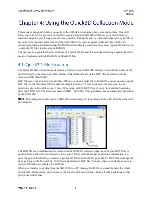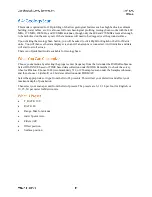
If you get an Error #3, this indicates that the SIR 3000 has not recognized the card. Pop the card out,
wait 5 seconds and reinsert.
This choice is available to allow you to use a USB ‘memory stick’ to transfer your data.
Any keychain drive that requires installation, drivers, or restart of a computer in order to have it
recognized will not work with the SIR 3000. GSSI has tested the Attaché USB 2.0 Flash drive by PNY
Technologies and has found it to work.
Turn on PC and SIR 3000. If the SIR 3000 has been running, stop all collection and playback
functions prior to continuing. Make sure that your memory stick is inserted AFTER powering up the
system.
Enter the TerraSIRch mode and click Run/Stop to pause the system.
Under the OUTPUT > TRANSFER submenu, click on HD.
A window will appear showing all files on the internal memory. Highlight the files and click Enter
once on each file to add a ‘check’ next to them. Once all files are ‘checked,’ click the Right arrow to
begin the transfer. This process will not delete the data from the internal memory.
Remove the USB Keychain/Pen Drive from the SIR 3000 and insert it into a USB port on your
computer. You can now access the data as if you had another disk drive on your computer.
While it is always advisable to keep the data on your system until you have downloaded it (if desired) and
checked the integrity of the data, eventually the memory may fill up or you may simply want to do some
‘housecleaning.’ GSSI suggests that you download all of the data from a particular jobsite and
completely delete the data before starting a new job. This will help to avoid confusion over which files
belong to specific projects.
Highlight Delete under the TRANSFER submenu, and push Enter. You will see a window with a list
of files.
Using the Up and Down arrow keys, highlight the file to be deleted and push Enter to place a ‘check’
in the empty box to the left of the file name.
Repeat until there are ‘checks’ next to all of the files you want to delete. Click the Right arrow key to
accept and delete those files.
When you attempt to collect a new file, the system will find the lowest number it can to assign to
the new file. For example: if you have 25 files, and you delete File_001, the next file will not be File_026,
it will be File_001. In other words, it will fill in any gaps in the memory before adding new files.






























